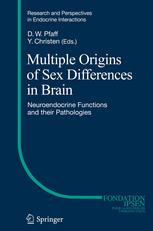

Most ebook files are in PDF format, so you can easily read them using various software such as Foxit Reader or directly on the Google Chrome browser.
Some ebook files are released by publishers in other formats such as .awz, .mobi, .epub, .fb2, etc. You may need to install specific software to read these formats on mobile/PC, such as Calibre.
Please read the tutorial at this link: https://ebookbell.com/faq
We offer FREE conversion to the popular formats you request; however, this may take some time. Therefore, right after payment, please email us, and we will try to provide the service as quickly as possible.
For some exceptional file formats or broken links (if any), please refrain from opening any disputes. Instead, email us first, and we will try to assist within a maximum of 6 hours.
EbookBell Team

4.3
28 reviewsIn theoretical terms, sex differences in brains and behaviors of laboratory animals offer the possibility of fascinating scientific studies on a range of molecular phenomena such as genomic imprinting, DNA methylation, chromatin protein modification, non-coding DNA, potentially resulting in important neuroanatomical and neurochemical sex differences in the brain. Such sex differences could arise consequent to exposures to testosterone early in development, or to other effects deriving from the Y chromosome. However, this general subject has been treated with much hyperbole. Historically, sex differences were assumed to be present where they did not really exist, e.g. with respect to mathematics, executive leadership, etc. etc. Under what circumstances do we really care about sex differences in brain and behavior? These circumstances concern human maladies whose diagnoses are much different between boys and girls, or between women and men. Prominent examples discussed in this volume include autism, attention deficit hyperactivity disorders and congenital adrenal hyperplasia. In fact, infant boys are more susceptible than infant girls to a variety of disorders that arise early in development. This volume then ends with a consideration of effects of estrogenic hormones on the injured brain, and their roles as protective agents.